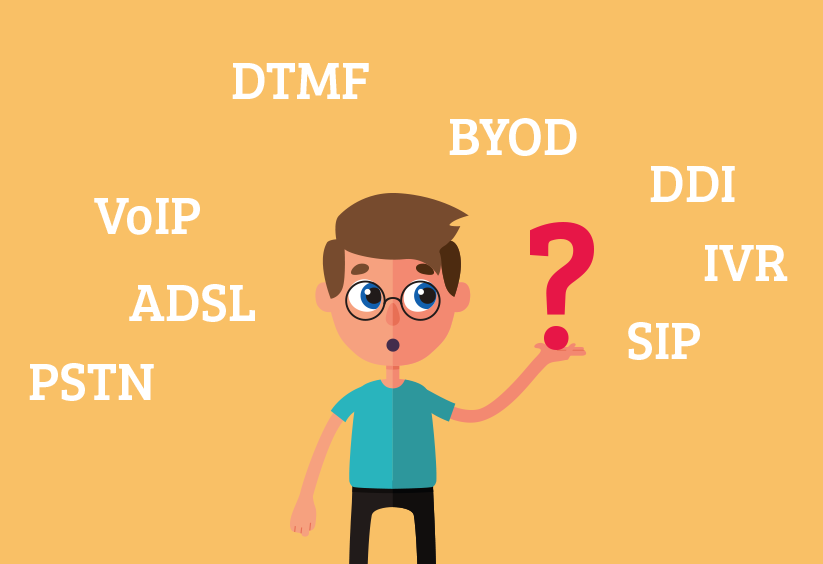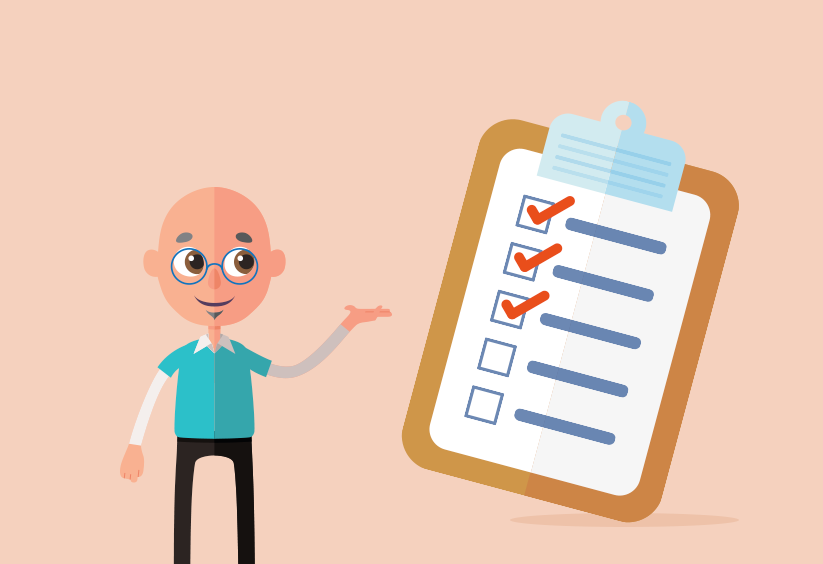Cart Total
$0.00
-
Your shopping cart is empty
Loading

Hello! Log in Your Account
New customer? Start here


|
5 min read
Contents
Quick Summary
Get to know your DTMF from your DDI when searching for a VoIP provider. Check out some of the more common VoIP terms.
If you're new to the world of VoIP and VoIP providers, the number of terms and acronyms you find yourself coming across can be a bit overwhelming. We've assembled a short list to help you become familiar with some of the more common terms you might discover when looking for a phone system.
VoIP stands for Voice over Internet Protocol. Sometimes known as Voice over IP, it is the method and technology for delivering voice data over the Internet. This is the basis for the VoIP telephony used in offices and homes. Hosted VoIP is a term that is used for VoIP services that are based online in the Cloud.
SIP is an acronym for Session Initiation Protocol. SIP works in conjunction with VoIP and is a communications signalling protocol that creates, modifies and terminates sessions with users. Essentially, SIP is used to start and end VoIP calls and is what establishes the session so you can talk over the Internet.
A Private Branch Exchange (PBX) often takes the form of a physical cabinet or box that sits in an office and routes incoming and outgoing calls to different phone extensions. Consumers are now leapfrogging PBX systems in favour of space-saving hosted VoIP Providers which route calls online via the Cloud.
ISDN first arrived in 1988 and is an abbreviation of Integrated Services Digital Network. Traditionally this allows the transmission of speech and data over copper telephone wires. An ageing and inflexible system, ISDN is being phased out around the world in favour of the scalability and ease-of-use of VoIP phone systems. BT (British Telecom) has announced that it will be phasing out all UK ISDN lines by 2025.
PSTN is a Public Switched Telephone Network and is a term used for the traditional landline. It uses circuit-switched telephony, with physical lines and automated telephone exchanges needed to make phone calls. Again, much like ISDN, this method of telephony requires engineers and installation and is seen as being less flexible than VoIP.
POTS excitingly refers to the term 'Plain Old Telephone Service' and is a term that is often used in place of PSTN.
Direct Dial-In or Direct Inward Dialing (DID) as it is sometimes known, enables callers to dial directly through to a specific extension without the need to go through a switchboard operator or receptionist. This feature is often associated with VoIP phones systems which provide separate extensions for individual staff members without the need for additional installation.
Dual Tone Multi-Frequency signalling is a telecommunication signalling system which is generated when a telephone touch key is pressed. Each key generates two tones of specific frequencies. DTMF is also referred to as 'touch-tone'. The touch-tone keypad eventually replaced the rotary dial that was used early on in the evolution of the telephone.
An IVR or Interactive Voice Response is the automated technology that interacts with callers and allows efficient routing to the appropriate department or member of staff. When making a phone call, callers use touch-tone (DTMF) keypad presses to select pre-programmed options or routes. This technology can be used for a variety of purposes, from making purchases via telephone to checking the weather conditions.
DSL is the acronym for Digital Subscriber Line. It is a collection of technologies typically used in modem or router to transmit data via telephone lines and is the prominent technology for broadband. The typical range for DSL services extends from 256 kbit/s to over 100 Mbit/s.
ADSL stands for Asymmetric Digital Subscriber Line. It is a type of digital subscriber line (DSL) broadband technology used for connecting to the Internet. It enables fast data transfer over a high bandwidth via telephone lines. ADSL modems accommodate voice data on the same line and provide an 'always on' continuous connection, unlike a regular dialup modem. With ADSL broadband technology, most of the channel is used to transmit downstream to the user with a small proportion given to upstream traffic.
Very-high-bit-rate Digital Subscriber Line is also a digital subscriber line but as you may have guessed is even faster than ADSL. The next step in high-speed broadband technology, VDSL systems can use frequencies of up to 30MHz, simultaneously providing data rates over 100 Mbit/s both downstream and upstream.
Bring your own device is a trend that is growing in both the workplace and across schools and colleges too. As the name suggests, this revolves around employees bringing in their own mobile devices or laptops into the office giving them the freedom to work from the comfort of their preferred phone. Because of the flexibility associated with VoIP providers, employees can route business phone numbers and services to their own phones or tablets without any constraints to the way that they work.
Hopefully, this brief summary of commonly associated abbreviations will help you when you are searching for the ideal VoIP service provider for your business. At the very least I hope you now know your DDI and DSL from your DTMF. If you think we've missed any, do give us a call or drop us a line!


Whether you’re just getting started or looking to sharpen up your business strategy, here’s how you can use social media to grow your business.
Posted March 19 2025 | 4 min

The best multi-line phone system is one that offers business-grade features like call queues and call recording for an affordable price. Discover how moving from analogue to digital VoIP can benefit enterprise or small business.
Revised July 5 2024 | 5 min

Migrating your organisation to a new phone system can seem daunting, but with our checklist, moving to VoIP can be a much smoother process for you.
Revised July 21 2022 | 5 min

Got a bad customer list as long as your arm? Need some actionable tips for conflict resolution over the phone? Here's our comprehensive guide.
Posted January 28 2022 | 19 min

For many personal users, Google Voice acts as an introductory experience to VoIP technology. For businesses, there's better out there.
Posted August 9 2021 | 7 min

Already using Yay.com as your business phone system provider? Learn more about our other services including domain name management and UCaaS.
Posted March 26 2021 | 4 min

True five star support in the telecoms industry is rare to find. Get to know our 5* support team more personally in this interview with two of its members.
Posted September 24 2020 | 12 min

With a 14 day free trial to Yay.com, you have a zero-cost, zero-risk period to try out any and all of Yay.com’s powerful features. Here’s what you can expect when you sign up.
Posted September 16 2020 | 4 min

Here are some ideas of how you can spice up your business phone system with custom audio and playlists.
Posted August 7 2020 | 4 min

Our call route page has been updated! Drag and drop is back; it's never been easier to configure your VoIP system's call routes.
Posted June 24 2020 | 6 min

Prepare for a boosted user experience with the new Yay.com dashboard
Posted February 21 2020 | 4 min

Learn all about our new Outbound Wallboards feature for Enterprise Users - outbound call statistics at-a-glance!
Posted January 31 2020 | 3 min

With upcoming General Data Protection Regulations (GDPR) coming into play on May 25th, learn what steps we have taken to ensure we're GDPR compliant.
Posted April 24 2018 | 3 min